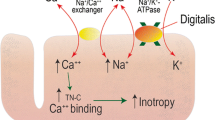Abstract
This article reviews the precautions and adverse effects associated with vesnarinone use, and the potential mechanisms responsible for these complications as well as suggested treatment strategies. Vesnarinone, a quinolinone derivative, improves the haemodynamics and quality of life in patients with congestive heart failure (CHF); however, it is associated with the adverse effects of increased sudden cardiac death and neutropenia. These adverse effects have limited the application of vesnarinone to the general population but perhaps with continued research into vesnarinone-induced neutropenia and advances in arrhythmia management, the risk/ benefit ratio of vesnarinone may become favourable. For now, the use of vesnarinone should be limited to patients with CHF who have demonstrated a poor response to other cardiac medications and devices. These patients should be closely monitored for both cardiac and non-cardiac adverse effects.




Similar content being viewed by others
References
OPC-8212 Multicenter Research Group. A placebo-controlled, randomized, double-blind study of OPC-8212 in patients with mild chronic heart failure. Cardiovasc Drugs Ther 1990; 4: 419–26
Feldman AM, Bristow MR, Parmley WW, et al. Effects of vesnarinone on morbidity and mortality in patients with heart failure. Vesnarinone Study Group. N Engl J Med 1993; 329: 149–55
Cohn JN, Goldstein SO, Greenberg BH, et al. A dose-dependent increase in mortality with vesnarinone among patients with severe heart failure. Vesnarinone Trial Investigators. N Engl J Med 1998; 339: 1810–6
Wandel C, Lang CC, Cowart DC, et al. Effect of CYP3A inhibition on vesnarinone metabolism in humans. Clin Pharmol Ther 1998; 63: 506–11
Kitakaze M, Fong M, Yoshitake M, et al. Vesnarinone inhibits adenosine uptake in endothelial cells, smooth muscle cells and myocytes, and mediates cytoprotection. J Mol Cell Cardiol 1997; 29: 3413–7
Kitakaze M, Minamino T, Funaya H, et al. Vesnarinone limits infarct size via adenosine-dependent mechanisms in the canine heart. Circulation 1997; 95: 2108–14
Toyama J, Kamiya K, Cheng J, et al. Vesnarinone prolongs action potential duration without reverse frequency dependence in rabbit ventricular muscle by blocking the delayed rectifier K+ current. Circulation 1997; 96: 3696–703
Feldman AM, Baughman KL, Lee WK, et al. Usefulness of OPC-8212, a quinolinone derivative, for chronic congestive heart failure in patients with ischemic heart disease or idiopathic dilated cardiomyopathy. Am J Cardiol 1991; 68: 1203–10
The Xamoterol in Severe Heart Failure Study Group. Xamoterol in severe heart failure. Lancet 1990; 336: 1–6
Packer M, Carver JR, Rodeheffer RJ, et al. Effect of oral milrinone on mortality in severe chronic heart failure. The PROMISE Study Research Group. N Engl J Med 1991; 325: 1468–75
Moss AJ, Zareba W, Hall WJ, et al. Prophylactic implantation of a defibrillator in patients with myocardial infarction and reduced ejection fraction. N Engl J Med 2002; 346: 877–83
Matsuyama Y, Ohashi Y, Uchino H, et al. Vesnarinone-induced WBC disorders in Japan. Pharmacoepidemiol- Drug Saf 1996; 5: 87–93
Furusawa S, Ohashi Y, Asanoi H. Vesnarinone-induced granulocytopenia: incidence in Japan and recommendations for safety. J Clin Pharmacol 1996; 36: 477–81
Bertolet B, White BG, Pepine CJ. Neutropenia occurring during treatment with vesnarinone (OPC-8212). Am J Cardiol 1994; 74: 968–70
Data on file. Tokyo, Japan: Otsuka Pharmaceutical Co., Ltd., 1996
Aizawa S, Nakano M, Yaguchi M, et al. Possible involvement of bone marrow stromal cells in agranulocytosis caused by vesnarinone treatment. Acta Haematol 1997; 98: 140–6
Nabeshima R, Aizawa S, Nakano M, et al. Effects of vesnarinone on the bone marrow stromal cell—dependent proliferation and differentiation of HL60 cells in vitro. Exp Hematol 1997; 25: 509–15
Busch FW, Tillmann A, Becker EW, et al. The inhibitory effects of a positive inotropic quinolinone derivative, 3,4-dihydro-6[4-(3,4-dimethoxybenzoyl)-1-piperazinyl]-2(1H )-quinolinone (OPC-8212), on bone-marrow progenitor cells and peripheral lymphocytes. Eur J Clin Pharmacol 1992; 42: 629–33
Matsumori A, Shioi T, Yamada T, et al. Vesnarinone, a new inotropic agent, inhibits cytokine production by stimulated human blood from patients with heart failure. Circulation 1994; 89: 955–8
Kondo T, Suzuki Y, Kitano T, et al. Vesnarinone causes oxidative damage by inhibiting catalase function through ceramide action in myeloid cell apoptosis. Mol Pharmacol 2002; 61: 620–7
Nara N, Kurokawa H, Tohda S, et al. Effect of vesnarinone, a quinolinone derivative, on the growth of leukemic blasts in acute myelogenous leukemia. Exp Hematol 1997; 25: 199–204
Uetrecht JP, Zahid N, Whitfield D. Metabolism of vesnarinone by activated neutrophils: implications for vesnarinone-induced agranulocytosis. J Pharmacol Exp Ther 1994; 270: 865–72
Guzey C, Spigset O. Genotyping of drug targets: a method to predict adverse drug reactions? Drug Saf 2002; 25: 552–60
Acknowledgements
The author has provided no information on sources of funding or on conflicts of interest directly relevant to the content of this review.
Author information
Authors and Affiliations
Corresponding author
Rights and permissions
About this article
Cite this article
Bertolet, B.D. Precautions for Use and Adverse Effects of Vesnarinone. Drug-Safety 27 (Suppl 1), 11–18 (2004). https://doi.org/10.2165/00002018-200427001-00003
Published:
Issue Date:
DOI: https://doi.org/10.2165/00002018-200427001-00003




